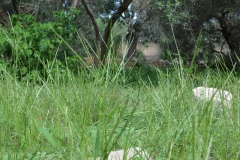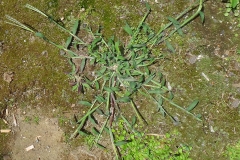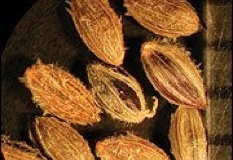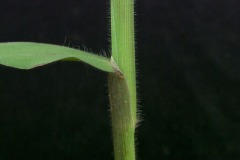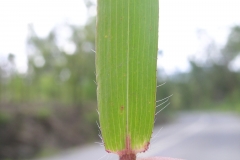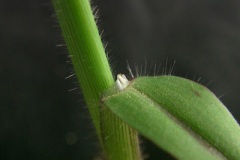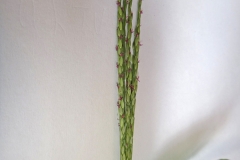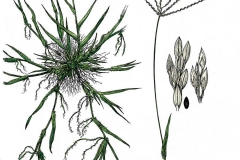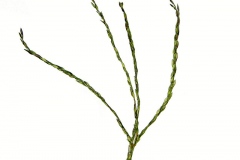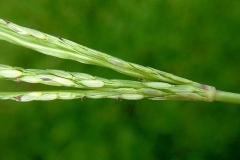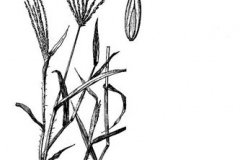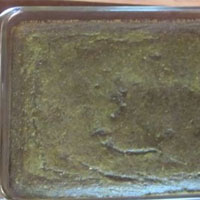Plant Description
Crab Grass is an annual, sparse, tufted decumbent, warm season, spreading grass that grows about 3-4 feet tall. The plant is found growing on waste ground, railway embankments, neglected lawns, grassy ridges, rocky, open ground, prairie openings, pastures, row crops, fields, turf, roadsides, gardens, weedy meadows, edges of degraded wetlands, vacant lots, grassy paths, highly disturbed areas and various waste areas. The plant prefers warm, sandy and fine-textured soils which are low in lime, but not in nutrient content. Roots are fibrous, sometimes forming from the nodes of the lower culms. The lower branches of the culms sprawl across the ground, while the upper branches are more erect. Large crabgrass has also been used as forage. Crabgrass is not regulated as a noxious weed in the Mid-South.
Leaves
Crab grass develops several branching culms at the base; the lower branches of the culms tend to sprawl across the ground, while their upper branches are more erect. The culms are light green, terete and glabrous, although they are mostly covered by the sheaths. The sheaths are light green, finely ribbed, shiny or dull, and hairy. Leaves are numerous near the base of the plant and scattered along the stems. They are soft and smooth, usually hairy near the base, 4-8 mm wide and with an open hairy sheath around the stem. Leaf blades are 4 to 15 cm long and 4 to 12 mm wide. Leaf blade is green to purple, both sides with silky, shiny hairs, often reddish with central strip and pale at the margin. Sheath green to reddish violet with long blister-like hairs, especially at the sheath base. Youngest leaf is rolled.
The central stalk of each raceme is light green, flattened, and about 1 mm across. There are many pairs of one-flowered spikelets along the length of each raceme; they occur along only one side of the flattened stalk. Each ovoid spikelet is light green to brownish green, flattened, and about 3 mm. long. The lemmas enclose a single developing grain. The blooming period occurs from August to September. Each grain is ovoid, 2 -2.2 mm long and flattened like the lemmas.
Traditional uses and benefits of Crab grass
- A decoction of the plant is used in the treatment of gonorrhea.
- A folk remedy for cataracts and debility, it is also said to be emetic.
- It is used as folk remedy for cataracts and debility.
Culinary Uses
- Seed is ground up and used as flour.
- It makes fine white flour that can be used for semolina.
Crabgrass Muffins
Ingredients
- 1 cup flour
- 1 cup crabgrass flour
- 2 teaspoons baking soda
- 2 teaspoons ginger (optional)
- 3/4 cup water
- 2 eggs
- 1 teaspoon vanilla
- 1/4 cup oil
- 1/2 cup raisins
Instructions
- Preheat oven to 350 degrees F.
- Place flours and baking soda in bowl, mix in water, eggs, vanilla and oil.
- Fold in raisins thoroughly Fill muffin tins 1/2 full or pour in 8 inch square baking pan.
- Bake 20 to 25 minutes
- Let cool and remove from pan.
Other facts
- Fiber obtained from the plant is used in making paper.
- A single plant is capable of producing 150 to 700 tillers and 150,000 seeds.
How to Get Rid of Crabgrass
Controlling Crabgrass before it Comes Up
If crabgrass has become established in your lawn, proper lawn maintenance alone may not be enough. A pre-emergent herbicide is the next line of defense. Pre-emergent herbicides work by killing the crabgrass seedlings as they germinate. When applying the pre-emergent herbicide, always follow the manufacturer’s directions. In general:
- Timing is vital when using pre-emergent herbicides. Application times depend a great deal on weather patterns, which vary from region to region. If your area has experienced a warmer than usual winter, you’ll probably need to apply the herbicide earlier than usual.
- Apply the herbicide when the ground temperature rises above 60 degrees. Since it’s hard for most of us to monitor the soil temperature, there’s an easier way. When you notice shrubs blooming and trees budding, it’s time to apply the herbicide. Warm nights and periods of rainfall encourage crabgrass germination. If your weather fits this pattern, get the herbicide in place right away.
- For newly seeded lawns, wait until you have mowed your lawn three times before applying the herbicide to avoid killing the new grass seedlings.
- Apply the herbicide consistently across your lawn. If you miss a spot, crabgrass can get established and then spread to the rest of your lawn.
- Do not de-thatch or ventilate the lawn after applying the herbicide. Doing so may break the chemical barrier of the herbicide.
- Wait two to four months to re-seed the lawn after using a pre-emergent herbicide.
- Use a pre-emergent herbicide during late winter or during early spring of the next year to prevent any crabgrass seeds left behind from developing at the next opportunity.
- Do not use a pre-emergent herbicide if crabgrass is already in the lawn or if you have just installed sod.
Killing Crabgrass after it Comes Up
If the crabgrass seeds have already grown and crabgrass has appeared in your grass, the pre-emergent herbicide will do no good. However, you still have an option. Post-emergent herbicide products control crabgrass after it has already germinated.
Post-emergent herbicides work by killing the crabgrass plants. Apply these herbicides only to the crabgrass that is visible. Read and follow the manufacturer’s directions on the product carefully. The amount of post-emergent herbicide that you can safely apply to your lawn depends on the type of grass you have. Here are some tips:
- Check the weather forecast before using a post-emergent herbicide. Apply the herbicide on a calm, sunny day. Rainfall shortly after application will wash the product away before the crabgrass has a chance to absorb it.
- For best results, apply the herbicide in the morning after the dew has dried. If you wait until late afternoon, dew or a shower may prevent maximum absorption.
- Post-emergent herbicides work best when temperatures are 60 – 90°F. These higher temperatures cause the plants to absorb the herbicide quickly; if the temperatures are too cool or weather conditions are too cloudy, the product is likely to be ineffective.
- Make sure the soil is moist before applying the herbicide. If not, you should water the area fairly extensively the day before treatment. If conditions are extremely dry, you may want to water again two days after the application. The waiting period will give the crabgrass time to absorb the herbicide.
- If you notice the lawn browning suddenly, you may have applied too much herbicide. In this case, water the area extensively as soon as possible to dilute the herbicide and keep it from further damaging your lawn.
- After treating the area with the herbicide, keep an eye out for newly germinated crabgrass plants. Any plants that may have germinated since the initial application will require a follow-up spot treatment.
- If the crabgrass plants are fairly well established, you’ll need to apply the herbicide twice. Treat the affected areas again four to seven days after the first application. Make sure the soil is moist before the second application.
- Follow the manufacturer’s instructions about when it’s safe to re-seed grass. Seed new grass in the area as soon as possible to establish healthy lawn crabgrass can’t break through.
- If you use a post-emergent herbicide during the summer, care for your lawn according to the lawn maintenance tips above.
- If the majority of your lawn is crabgrass, it may be best not to remove it during the summer. Wait and renovate the lawn in the fall.
Preventing Crabgrass in the Future
The best defense against crabgrass is a healthy lawn. Unwanted grasses and weeds simply can’t get the necessary toehold to thrive in a robust stand of grass. Follow these basic lawn care guidelines to keep crabgrass from becoming a problem in your yard:
- Mow at frequent intervals to keep the grass a fairly consistent length. Check the recommended mowing heights for your type of grass and cut your lawn at the highest recommended setting. Crabgrass requires plenty of light to germinate, so keep the grass as thick and long as possible to create shade near the soil surface. Cutting your lawn too close produces patches where crabgrass and other weeds can germinate.
- Remove no more than one-third of the grass blade at one time when mowing. Removing more not only allows more light to reach weeds, it also can injure the grass.
- In an established lawn, water in long, heavy intervals rather than shallow, frequent ones. Watering on an irregular schedule and only when needed promotes deeper root growth that’s essential to healthy turf grass. Remember that most established lawns require about one inch of water per week from rain or irrigation. If your lawn is newly-seeded, water in shallow, more frequent intervals until the grass gets established.
- Fertilize your grass at least once a year, following the package instructions.
References:
https://www.itis.gov/servlet/SingleRpt/SingleRpt?search_topic=TSN&search_value=40604#null
http://www.hear.org/pier/species/digitaria_sanguinalis.htm
https://pfaf.org/user/Plant.aspx?LatinName=Digitaria+sanguinalis
https://www.cabi.org/isc/datasheet/18916
http://www.floracatalana.net/digitaria-sanguinalis-l-scop-
https://plants.usda.gov/core/profile?symbol=DISA
https://www.inhs.illinois.edu/data/plantdb/detail/2827
https://www.gri.msstate.edu/research/ipams/FactSheets/Large_crabgrass.pdf
https://wiki.bugwood.org/HPIPM:Crabgrass
https://wikivisually.com/wiki/Digitaria_sanguinalis
http://www.theplantlist.org/tpl1.1/record/kew-409361
https://indiabiodiversity.org/species/show/258743
https://en.wikipedia.org/wiki/Digitaria_sanguinalis
https://npgsweb.ars-grin.gov/gringlobal/taxonomydetail.aspx?id=14103
https://gd.eppo.int/taxon/DIGSA
http://www.stuartxchange.org/CrabGrass
https://www.minnesotawildflowers.info/grass-sedge-rush/hairy-crabgrass
Comments
| Crab Grass Quick Facts | |
|---|---|
| Name: | Crab Grass |
| Scientific Name: | Digitaria sanguinalis |
| Origin | Europe or Eurasia and is distributed worldwide |
| Colors | Dark purplish |
| Shapes | Caryopsis enclosed in 2 sterile flowering-glumes, 2-4 mm (0.078 - 0.157 inch) long |
| Health benefits | Beneficial for gonorrhea, cataracts and debility. |
| Name | Crab Grass |
|---|---|
| Scientific Name | Digitaria sanguinalis |
| Native | Europe or Eurasia and is distributed worldwide |
| Common Names | crabgrass. hairy crabgrass, hairy finger-grass, large crabgrass, crab finger grass, purple crabgrass |
| Name in Other Languages | Albanian: Digitarie, meli i përgjakur Arabic: Abu rokba Argentina: Pasto colchón, pasto cuaresma Bontoc: Pagpagai Brazil: Milha-de-pendao Bulgarian: Kŭrvava rosichka (кървава росичка), krŭvno proso (кръвно просо) Catalan: Forcadella Chinese: Ma tang (马唐) Croatian: ljubičasta svračica Czech: Rosička krvavá, rosi Danish: Blodhirse Dutch: Harig vingergras, Bloedgierst, haarig vingergras English: Common crabgrass, Hairy fingergrass, Large crabgrass, hairy crabgrass, crabgrass, Purple crabgrass, crab finger grass, hairy summer grass, summer grass, Northern crabgrass, red fingergrass Estonian: Verev paelhirss Finnish: Verihirssi, Rikkaverihirssi French: Digitaire sanguine, Panic sanguin, Millet sanguine, manne terrestre, sanguinette, Digitaire commune, Sanguinelle, Digitaire pourpre, Panic pourpré German: Blut-Fingerhirse, Blutrot Fingerhirse, Blutfennich, Bluthirse, Himmelstau, Mannahirse Greek: Aimatóchorto (αιματόχορτο) Hebrew; Etzbe’an ma’adim, atsben madim (אֶצְבְּעָן מַאֲדִים) Hungarian: Pirók-ujjasmuhar Iloko: Saka-saka Italian: Sanguinella comune, , Sanguinella, Sanguinaria, digitaria sanguinella Japanese: Inubie, mehishiba, onime-hi-shiba (オニメヒシバ) Lithuanian: Raudonoji pirštuotė, Šukinė pirštuotė Latvian: Asinssarkan, asinssarkana pasāre Malay: Rumput jejari berbulu Maltese: Diġitarja ħamra Netherlands: Bloedgierst Norwegian Bokmål: Blodhirse Occitan: Sannissoun Polish: Palusznik krwawy, palcowe ziele, proso kwawe Portuguese: Milha digitada, Milha, pé-de-galinha, milhã-de-pendão Romanian: Meişor Russian: rosichka krovavo-krasnaya (росичка кроваво-красная), росичка кровавокрасная (росичка кровавокрасная), rosichka kroveostanavlivayushchaya (росичка кровеостанавливающая), rosichka krovyanaya (росичка кровяная) Serbian: svrakonj (свракоњ), crvena svračica (црвена сврачица) Slovak: Prstovka krvavá Slovene: Egiptovka srakonja, krvavordeča srakonja Spanish: Pasto de cuaresma, conejo, frente de toro, fresadilla, garrachuelo, gaudín, guardarrocio, manga larga, pasto cangrijo, pasto colchón, pasto cuaresma, pata de gallina, pata de gallo, pata de paloma, alpiste cimar, pasto de cuaresma, pendejuelo, sombrillitas, zacate digitaria, zacate pata de gallina, Pé-de-galinha Swedish: Blodhirs, Rikkaverihirssi Turkish: Büyük yengeç out, kızıl çatalotu Ukrainian: Palʹchatka krov’yana (Пальчатка кров’яна), palʹchatka yehypet·sʹka (пальчатка єгипетська) Welsh: Byswellt blewog |
| Plant Growth Habit | Annual, sparse, tufted decumbent, warm season, spreading grass |
| Growing Climates | Found on waste ground, railway embankments, neglected lawns, grassy ridges, rocky, open ground, prairie openings, pastures, row crops, fields, turf, roadsides, gardens, weedy meadows, edges of degraded wetlands, vacant lots, grassy paths, highly disturbed areas and miscellaneous waste areas |
| Soil | Warm, sandy and fine-textured soils which are low in lime, but not in nutrient content |
| Plant Size | About 3 1/2 feet in height |
| Root | Roots are fibrous, sometimes forming from the nodes of the lower culms. The lower branches of the culms sprawl across the ground, while the upper branches are more erect |
| Culms | Light green, teret, and glabrous, mostly covered by sheaths |
| Sheath | Light green, finely ribbed, shiny or dull, and hairy |
| Leaf | Leaf blades 5-15 cm long and 3-12 mm wide. Leaf blade green to purple, both sides with silky, shiny hairs; often reddish with central strip and pale at the margin. Sheath green to reddish violet, with long blister-like hairs, especially at the sheath base. Youngest leaf rolled. Ligule membraneous, white, 1-2 mm long, truncate |
| Flowering season | August to September |
| Fruit Shape & Size | Caryopsis enclosed in 2 sterile flowering-glumes, 2-4 mm (0.078 – 0.157 inch) long, greenish-gray, halved-fusiform |
| Fruit Color | Turn dark purplish as they mature |
| Seed | Shiny, yellowish-brown, 2-3 mm (0.078 – 0.118 inch) long |
| Propagation | By seed |
| Plant Parts Used | Whole plant |



